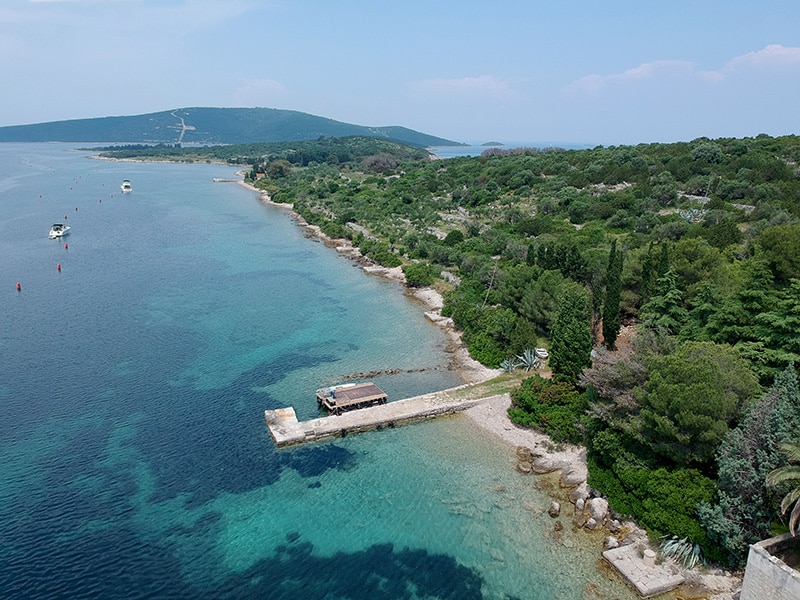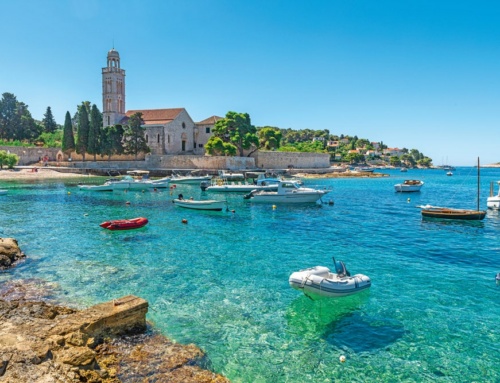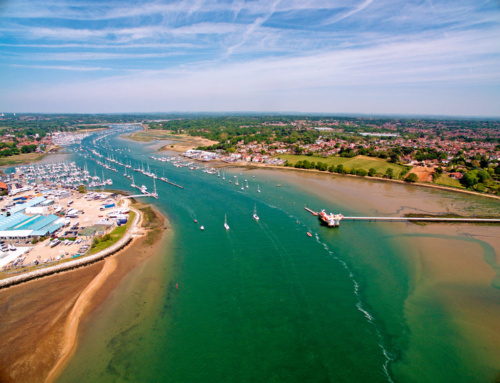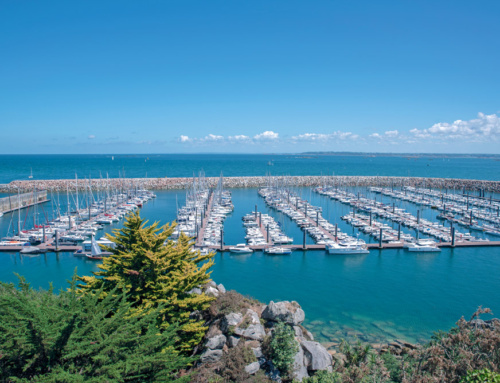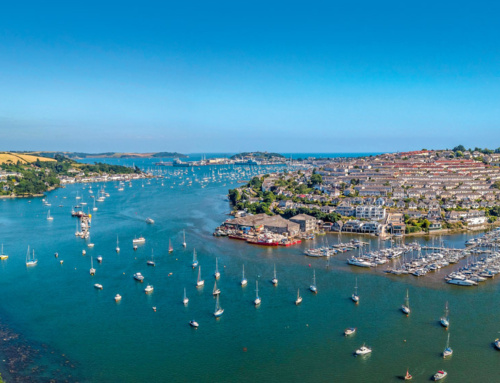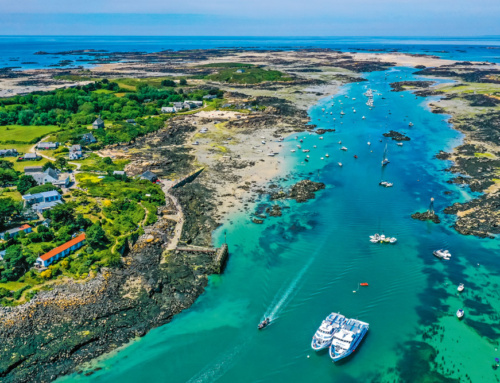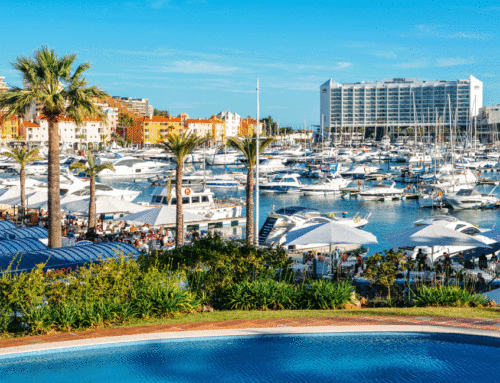There are few places on earth that offer quite as much beauty, history and culture as Croatia. It possesses a coastline famed for its ‘fairy-tale’ islands and myriad nooks and crannies, all waiting to be discovered by those setting out to explore its turquoise waters. PBR correspondent Penny Jackson invites us to accompany her on a journey to sample Istria, one of Croatia’s most beautiful coastal regions, and provides essential insight into how you too can experience all that this enchanting coastland has to offer.
As we wound our way down the road and into the tiny harbour of Luka Krnica we could see Franco, the owner of the only restaurant, standing in a boat cleaning that day’s catch. ‘Ten minutes and the fish will be in the kitchen!’ he shouted. This is Istria, or rather the Istria you have to seek out away from the main tourist centres in Croatia’s most westerly territory, which sees thousands of holidaymakers every year from all parts of Europe.
Before Franco delivered the plates of sea bass to our table, served the simple Croatian way, i.e. grilled with a dressing of oil, garlic and parsley, he stopped to speak to other guests in fluent Italian and German. Nothing could have summed up better Istria’s heritage as the possession of rival European states over centuries.
Its strategic position in the northern Adriatic tempted invaders from Roman times as power was seized by one from another ‒ empires, feudal families, republics ‒ legacy upon legacy creating the layers of history so evident today. Locals will tell you how their families were born under Austrian rule, grew up Italian, became Yugoslav and are now Croatian.
The Istrian peninsula, shaped rather like an ice cream cone, juts into the turquoise waters of the northern Adriatic between the Gulf of Trieste and the Kvarner Gulf, which melts into the Dalmatian coast. Quite different from the hotter and less verdant south of Croatia, Istria is lush and green, with romantic hilltop towns and a wooded shoreline of coves and inlets, shingle beaches and small fishing ports dotted along its more than 500 kilometres of coast and islands.
The best-known names running up the popular west coast from Pula, Istria’s largest town at the southern end, are Rovinj ‒ a ‘little Venice’ ‒ and just across the water Porec, and then Umag, which almost touches the border with Slovenia. Italy also has a slither of territory in Istria, although its size doesn’t begin to represent the strong Italian influence in terms of language, culture and cuisine. The towns still carry their Italian names alongside the Croatian ones.
But the eastern side of Istria is not nearly such a well-beaten track, with its steeply rising rocky coast that is more rugged than the flat west, and as such, a joy to explore. It has bays of crystal-clear water, often empty of holidaymakers even at the height of the holiday period. Those of us who choose to walk in summer temperatures down rough stony paths in order to find a particularly beautiful spot can only look enviously at anyone who discovers it by boat and remains anchored there until dusk.
Just two days after our meal in the fish restaurant we found ourselves on a catamaran heading for the islands in Kvarner Bay, with the largest, Cres, being visible from the headland in Luka Krnica as a shimmering outline on the horizon. ‘Go to Lošinj,’ Franco urged us. ‘It is beautiful without too many people.’ We then discovered it has excellent hotels as well. Our delightful but simple stay in Istria ‒ stone cottage, small village, homely restaurants ‒ was about to receive an injection of luxury. The 36 Cres-Lošinj islands, islets and reefs are the largest group in the Adriatic, with many being uninhabited, and it is the relative difficulty in reaching them that has by all accounts preserved their special feel.
To the island of Lošinj
The ferry we had boarded in Pula, three hours earlier, slowed as it entered the 3-mile-deep natural bay in the port of Mali Lošinj, the main port of entry for this part of Croatia and said to be the most stunning in the Adriatic. The sea was summer calm, but as anyone who has ever sailed in the Adriatic will tell you, winds can come from nowhere. We caught a first glimpse of the pretty painted houses lining the harbour front, vivid in the strong sunshine, and as we hugged the long shoreline it was easy to see why this was a vital shipping hub, both naval and commercial, for hundreds of years.
Today, the coastline of the island, which is 21 miles by 2 miles, is a magnet for boaters, who have the choice of three marinas in Mali Lošinj: the yacht club marina, which is positioned just in front of the entrance to the town and has berth services for 110 boats up to 30m in length, and two other marinas on the approaches to the old harbour, around a mile from the town centre. There are four smaller harbours on the east coast, with most anchorages being on the west of the island, north and south of Mali Lošinj.
Our destination, though, was the Boutique Hotel Alhambra in Čikat Bay, and when we arrived it was immediately clear why this lovely setting became a popular destination for wealthy Austrians in the 19th century and the favourite resort of the Austro-Hungarian emperor Franz Josef. Once known as the ‘imperial inlet’, the azure-coloured water stretches from its narrowest point to the mouth of the bay some 500 metres across, and at its tip is the Alhambra, redesigned four years ago with an annex linking two historic villas ‒ a stunningly elegant design sensitive to its history and environment. Inside and out, attention has been given to every detail, and extravagant use of beautiful natural stone is apparent everywhere. Surrounded by pine forest that seems almost to dip into the bay, it felt remarkably peaceful and gave the lie to the number of people making the most of the activities and water sports on offer.
And there are plenty of those for anyone who wants more than a sunbed and a cool drink. Scuba diving, snorkelling, kitesurfing, walking or cycling across the island, even parachuting are all available for the intrepid, and all come with the necessary instruction. But the real treat lying in wait is for tennis enthusiasts. The island has a long pedigree in the sport and virtually all Croatia’s champions, such as Goran Ivanisevic and Marin Cilic, will have competed or trained there at some point in their formative careers. As a tennis coaching facility, it is at the top of its game. There are 26 clay courts divided among three centres and mostly laid out among trees that shelter the courts from the afternoon sun. Taking full advantage of the chance to improve a weak backhand, we asked the Alhambra to arrange a coaching session with one of their nationally recognised coaches, who homed in on my flawed strokes with satisfying authority. All players are assessed for ability and fitness before they sign up for coaching.
At the end of this, the place to head for was the Alhambra’s spa. The only other guest was from one of the sumptuous fully serviced villas the hotel also offers. Lošinj sells itself as the island of ‘wellness and vitality’, its health-giving credentials stretching back to the research of a 19th-century botanist who decided that its location, temperatures, quality of air and aromatic plants made it the healthiest climate in the Austro-Hungarian Empire. Cocooned as I was in the Cube Spa climate breathing in an aura of scented oils and purifying herbs, the Alhambra Purity Massage somehow managed to be both stimulating and soporific. Apart from all the beauty treatments created for body and soul, the silky salt water of the indoor pool was enough in itself.
The sea is a stone’s throw from the hotel, but where it laps the shore it cannot by law in Croatia be private, so exclusivity in every resort is maintained by pricing out non-guests from the sunlounging areas waited on by hotel staff. If guests here want an outdoor pool they can use the facilities at its sister five-star hotel, the Bellevue, a hop and a skip away.
For our first evening, we ate a memorable meal at the hotel’s highly praised restaurant, Alfred Keller, named after the architect of the original Alhambra. The dining terrace has an idyllic view of the bay, visible even at night thanks to the subtle lighting along the long promenade stretching to the headland. The tasting menu was a testament to local produce prepared to the highest standard of culinary skills, with a twist that never overpowered the main ingredient. Guided by the sommelier, we discovered how Croatian wine now competes with the best. This is not the tourist Croatia of plastic menus and picture-led dishes that are so prevalent in many resorts.
Diners at one of the large tables had clearly come for a night out from a yacht moored in the bay. The hotel can organise a shuttle for guests, and indeed any outings by boat through Jadranka Yachting. Earlier we had spent some time on a speedboat bouncing across the waves to Ilovik, the southernmost inhabited Lošinj island.
On our last evening we walked the 15 or so minutes to the Lanterna restaurant at the mouth of Čikat Bay. Its name is derived from the Croatian word čekati ‒ ‘to wait’ ‒ and this is where the wives and sweethearts of mariners would watch for a sight of their returning menfolk. Now it is the place to bag a table overlooking the sea and watch the sun set. It is also the spot to eat the tastiest grilled lamb imaginable, due to the animals’ salt-blown diet on Cres.
In the other direction from the hotel, a 15-minute walk along the promenade leads back to Mali Lošinj and the bustling streets with their restaurants, shops and art galleries. It is worth visiting the Museum of Apoxyomenos, which is entirely dedicated to only one exhibit – the bronze statue of a young athlete discovered in 1997 by a Belgian tourist at a depth of 45 metres. Two years later it was taken out of the sea, where it had spent nearly two millennia.
The second town on the island, Veli Lošinj, is compact and small in comparison, but equally as pretty. The freshly painted sea merchants’ houses that face the harbour ‒ limited in size and unsuitable for large vessels ‒ were specifically meant to show a modest face to the world so that pirates would have no idea of the riches they concealed. This is where the scientifically based dolphin centre is found along with the baroque church of St Anthony Abbot the Anchoret, with its remarkable collection of paintings by Italian masters.
Our luxury break receding fast, we headed back to Istria via the elongated island of Cres, connected to Lošinj by a narrow bridge that is raised twice a day for marine traffic too large to sail underneath. At Osor on the Cres side, there is a small marina with 50 wet berths, a 50-minute drive away from Porozina port, where we crossed by ferry to Brestova on the east coast of Istria. There is another route via road and ferry from the island of Krk, which is where Rijeka Airport is located. Indeed, Lošinj does have a small airstrip and there are seasonal summer flights from Zagreb, the Croatian capital, Venice and Lugano.
Inland Istria
In central Istria there isn’t anywhere more than 30 minutes from the coast, and Pula is the main point for boat hire and charter and car hire. Its airport is just 20 minutes from the town. However, no one should be in a rush to leave the city. Its industrial feel on the fringes and its shipyard close to the main port may be unlovely but its historic centre is too interesting to miss.
As the gateway to the Istrian peninsula, the view from the harbour of its magnificent Roman amphitheatre suggests the centuries of history waiting to be peeled away. It is a showstopper, just as it was intended to be in the first century AD, and its state of preservation ranks it sixth among structures in the area that was once the Roman Empire. In July it hosts the annual Pula Film Festival, and for the summer months it becomes a stage for world-class performers in concerts from rock to classical to dance. Wander into the heart of the old town and have a coffee in the public square on the site of the Roman city’s forum and you will be gazing at the Temple of Augustus dating from 28BC, which had to be put back together after a direct hit from a bomb in the Second World War.
The range and standard of accommodation here, and in fact throughout Croatia, is extremely high and bears no resemblance to the old days of mass packet tourism. Hotels ‒ whether small family-run, chichi boutique, sophisticated, architecturally cutting-edge or a room in the agro-tourist sector ‒ all pretty well deliver on the expectations of guests used to a high degree of comfort. Even in the smallest Istrian town there are holiday homes to rent ‒ and almost certainly with a pool.
In Pula, the Hotel Amfiteatar, next to the arena, is modern and comfortable with a good restaurant and parking and in a great location close to the harbour.
Away from the sea, it is the Istria of hilltop towns, vineyards and olive groves that draws visitors inland and invites comparison with Tuscany. Given that you can drive the peninsula in an hour and a half from top to toe, there is no town out of reach for a day trip. Pazin, in the heart of Istria, is the capital city and has a medieval castle built on solid rock above a deep chasm, and a turbulent history. It perhaps doesn’t have the appeal of prettier towns, but nor does it have the crowds, unlike ancient walled Motovun, the best known of all. The landscape here towards the north opens out into one of hills, hollows and plains, and Motovun is famous for its film festival and the stupendous views from its ramparts. Less than a 30-minute drive away is Groznjan, another picture-perfect hilltop town that became something of an artists’ colony when the village emptied in the 1950s. As well as galleries, it has musicians galore and an annual jazz festival.
But our most treasured discovery was in the village of Beram. We had an appointment to visit the tiny cemetery church of St Mary’s, with its frescoes from the 15th century, and were to meet the ‘lady with the key’ in the village. We waited in the Konoba Vela Vrata, a restaurant serving fresh pasta and truffles with steak grilled over a wood fire. If we were disappointed to miss the food, the frescoes more than compensated. The walls are covered with 40 scenes from the New Testament and are some of the most beautiful in Croatia.
West coast wonder
It is no exaggeration to describe Rovinj as the ‘Pearl of the Adriatic’. Until 1763 it was an island, and it still has a special feel. The Venetian influence is more strongly felt here than almost anywhere, with its narrow lanes, piazzas and grand Venetian-style houses. The twisty streets spiral upwards towards the Church of Sant’Eufemia, which not only dominates the old town that rises directly from the sea but is visible for miles. It is the highest church tower in Istria. Walking down the slippery ancient stone-flagged streets requires care, but en route, stop off for one of the best restaurants in Istria. The Monte was the first Croatian restaurant to win a Michelin star. For a beachside restaurant with a view of old Rovinj, Restaurant Blu has tables on the edge of the sea and is equally good for a lazy meal during the day or in the evening.
Rovinj is still a fishing port but its harbour is one of the busiest on the coast, and like Dubrovnik it is a stop for cruise ships. The ACI marina Rovinj is a short distance from the city centre, surrounded by pine woods and open all year round. It has 380 moorings in the sea (which also include mooring facilities for large yachts) and 40 moorings on the land.
Only 15 miles north of Rovinj is Porec, which boasts one of the finest examples of Byzantine art: the gold mother-of-pearl mosaics in the sixth-century Euphrasius Basilica. The town is one of the most visited destinations and was among the first in the 1960s to encourage tourism, with its strip of hotels and campsites to the south located unobtrusively among pine trees and close to the shore.
Out to sea
A useful starting point for cruising in the Adriatic is a marina on the southern tip of Istria in the deepest part of Medulin Bay. ACI Pomer was revamped three years ago and provides 294 berths and 30 dry berths and a host of facilities for boaters, from a swimming pool, restaurant and laundry to spacious storerooms. This is a windy part of Istria, surrounded by sea on three sides, perfect for wind- and kitesurfing. It is also close to Cape Kamenjak, a lovely nature park with miles of rugged coastline that can be explored by foot or on a bike. But undoubtedly the best way is by boat, which can be anchored in any number of coves. There is a chance of seeing dolphins, and swimmers and snorkellers can explore some of the small caves. The spiky sea urchin thrives in the clean water everywhere along these coasts, and wearing shoes should not be dismissed lightly.
But in terms of recent history, there are no islands of more significance than the Brijuni Islands, an archipelago of two main islands and 12 islets a few miles north-west of Pula and now a national park. Boats, though, need permission from the National Park Administration and many passages between the islands are tricky to navigate. Temporary mooring is allowed in designated bays, and berthing fees are deliberately extremely high to deter all but the most determined or wealthiest. The easiest way to get there is on the short ferry trip from Fažana on the mainland. While Tito was president of Yugoslavia, the islands were out of bounds to anyone who was not his guest, and it was where he entertained leaders from around the world. Some even gave animals as gifts, which was the start of the wildlife safari park, now rather depleted. In the old stable block there is a carriage given to Tito by the Queen.
The main, and only inhabited, island, Veliki Brijun, comprises meadowland, oak and laurel forest with many rare trees and plants. Paths criss-cross the car-free island past Roman remains and settlements, and visitors can hire buggies or bikes. There is a small museum and just two hotels. The island has a rare tranquillity, and if you stay overnight, after the last day visitors have returned to the mainland, you have the island to yourself. It truly is magical.
Click & Boat
Click & Boat have around 125 motor boats listed on their platform in the broader region of Istria, Croatia. Like the rest of Croatia, this region is very popular among German, Austrian and Eastern European families, who mostly hire motor boats there in the summer. This is increasingly the case for Brits, Americans and Aussies too, although these tend to be younger, around 25‒35 years old, and usually hire a motor boat to hold a party and/or celebrate a special occasion or go exploring. In most cases, renters book a motor boat in Istria for a week or so (usually booking around two months in advance). Many renters hire smaller motor boats for island-hopping trips (2‒3 days), or just for a day. For short-term rentals, booking three weeks in advance is more than enough. Two of the most popular types of motor boats hired via the platform in Istria are Merry Fishers and Jeanneau Cap Camarats. The best time of year to book a boat there is September ‒- the weather is still good but booking prices can be considerably lower than those in the high season (15th July – 15th August). The most popular destinations for a motor boat trip in Istria include Rovinj, Pula and Porec. Many renters also sail to the Kvarner region (Rab, Krk, Cres, Opatija, Kornati National Park) or nearby boating destinations in Italy, e.g. Venice or Trieste. Historically, Istria is located at the crossroads of Italy and the Balkans, resulting in an idiosyncratic cultural mix that makes the region a unique place to explore in a motor boat.
The Bura
The Bura is a strong unpredictable wind that in summer provides welcome relief from humidity and clears the air. However, it also represents a danger for mariners as it can appear suddenly with gale-force gusts capable of whipping up the sea into a fury. It is more prevalent in the northern Adriatic than the south, but though meteorological reports give prior warning of the Bura, the best defence is often the naked eye and getting to know the telltale signs. Look out for thin white clouds forming over the peaks of coastal mountains, often in the afternoon when warm air begins to interact with the colder, seaborne breezes. Short, sharp, steep waves require quick action and a run for any lee that can be found.
Borrow a Boat
The Borrow a Boat concept makes hiring or chartering a boat quick and easy. Even at short notice, you can tap in the location, date or type of boat to see what is available for as many days as you want. With marinas full of boats not going anywhere, this is a win-win situation for both owner and renter. Croatia is one of their 62 locations worldwide, with RIBs to luxury sail boats on their database. You can add a skipper if you don’t sail yourself. Pula is the nearest location for the northern Adriatic.
borrowaboat.com (+44 (0)1245 230704)
The Globe Sailor (www.theglobesailor.com): hire a powerboat, yacht, gulet or catamaran from Pula close to the Adriatic Croatia International Club.
Adriatic Yacht Charter (www.ayc.hr) has a marina in Medulin, 10km from Pula.
Croatia Charter (croatiacharter.com) is based in Pomer, well located for the east coast of Istria.
Yacht Charter Croatia (www.clickandboat.com) provides a wide selection of boats in numerous ports around the country, including Rovinj and Mali Lošinj, with or without a captain.
For further marine information from the Mali Lošinj tourist board visit www.visitlosinj.hr (+385 (0) 231 884).
Where to stay
Lošinj Hotels and Villas (booking@losinj-hotels.com) (+385 (0)51 661 111) offers a choice of five hotels, including the five-star Boutique Hotel Alhambra, Villa Augusta and Hotel Bellevue. It also has the family-friendly Vespera, the Aurora Wellness Hotel and the Vitality Hotel Punta, as well as serviced villas. A double for one night in July at the Alhambra starts from £381 and the Vespera costs from £182 on booking.com.
In Pula, at the Hotel Amfiteatar (info@hotelamfiteatar.com) (+385 (0)52 375 600), a double in July costs from £92 a night. Outside the town on the beachside Verudela peninsula the Park Plaza Arena Pula is £157 a night on booking.com. There are numerous options for rooms in private accommodation and small apartments. In Rovinj, choices range between the old town, an elegant resort district or an island. A room at the five-star Hotel Monte Mulini (www.maistra.com) (+385 (0)52 800 250) in July costs £426 a night on expedia.com. In the old town there is plenty of private accommodation, but cars are parked elsewhere. The Heritage Angelo d’Oro Hotel costs from £145 a night. San Rocco (san-rocco.hr) (+385 (0)52 725 000), a Heritage Hotel and gourmet restaurant, was part of an old family estate in Brtonigla, a town in north-west Istria, well located for the coast and inland towns. High-season prices are from £179 per night (209 euros).
Istria tourist board: www.istra.hr
Croatian National Tourist Office London: www.visit-croatia.co.uk
Villas, stone cottages and apartments to rent are plentiful in Istria.
Vintage Travel have handpicked villas in Istria: www.vintagetravel.co.uk
Istrian Villas specialise in this region: villsy.com
Croatian Villas: www.croatianvillas.com
Villas Croatia: www.villascroatia.net
HomeAway.com is a direct booking agency.
Travel to Croatia
By air … Ryanair (www.ryanair.com) fly from Stansted to Pula twice a week from the beginning of April and three times a week from June until the end of September. They also fly to Rijeka twice a week from Stansted between June and September.
EasyJet (www.easyjet.com) fly from Gatwick to Pula from the end of April until the end of October. During June, July and August they have four flights a week. They also run a twice-weekly service from Southend to Pula between May and October.
Jet2 (www.jet2.com) fly to Pula once or twice a week from five UK airports: Manchester, Birmingham, Leeds Bradford, Stansted and Edinburgh.
Thomson (tui.co.uk) fly three times a week from Gatwick between May and September.
From Trieste, Italy, it is less than an hour’s drive to Umag on Istria’s border with Slovenia, but beware of slow border traffic in peak summer months.
By sea … Start or finish in Venice with ferries to all the major ports in Istria (www.croatiaferries.com). The Venice‒Rovinj run is between 2 hours 45 minutes and 3 hours 45 minutes depending on the route.
The ferry route to Mali Lošinj is currently served by Venezia Lines. In the high season the ferry runs twice a week from Venice and the journey time is between 4 hours 45 minutes and 5 hours 30 minutes.
Pula to Mali Lošinj: ferries run six times a week in high season, taking from under 1 hour 50 minutes to 3 hours 25 minutes, depending on the route.
Croatia ferries have timetables for the whole Adriatic coast.
www.navily.com offers a lot of information on the marine services available in and around the Croatian coast and its cruising waters. Marinas, harbours, anchorages and other valuable local knowledge can be accessed through this specialist marine resource.
Taste of Istria
Food and drink … Summer is all about fish and shellfish, pasta, risotto, grilled sea bass (brancin) and scampi ‒ fat juicy langoustines not tasteless breadcrumbed tails ‒ and clams and oysters from the Limski Kanal near Rovinj. Calamari (squid), fried or grilled, is a staple of every restaurant and delicious when fresh, but it is not likely to be in the hot summer months. Italian influence is ever present: gnocchi and light meat stews, pršut (delicious cured and dried ham), kulen (sausages, dried and smoked) and seasonal wild asparagus for soups. Maneštra, the hearty Istrian minestrone soup, is a wonderful meal in itself. Look out for beef dishes with boškarin, the Istrian long-horned cattle, and teletina (veal), oven roasted. And then there’s fusi, home-made tube pasta, with goulash or truffles. And this is big truffle country, with truffle festivals in the autumn. Istria produces 10 per cent of Croatia’s olive oil from 20 or so mills ‒ many are organic family producers whose craft has brought international awards. Look for the Istrian varieties: buža, oblica, istarska bjelica, rošinjola and črnica. Croatian wine, and Istrian in particular, is a real highlight. The climate is kind to viticulture, and the north-west corner of Istria is now a wine lover’s paradise. Teran, grown in the red soil so striking in Istria, has won major awards including Decanter World Wine Awards, and Istria was the wine region of 2017. Last year, Istria dominated the list of winning Croatian winemakers with five out of the ten gold awards. Seek out bottles of the delicious Malvazija. Visit the well-known Kozlović winery in the north-west of Istria (www.kozlovic.hr). And for non-drinkers, Jamnica, the Croatian sparkling mineral water, is one of the best around.
Navily ‒ free community cruising guide
You can download Navily’s free app to access the reviews and photos of more than 100,000 boaters on anchorages and marinas. Calculate berth prices for your boat, and easily and straightforwardly book a berth in Croatian marinas. Discover more than 1,000 anchorages, with information on seabeds, protection against wind and swell, buoys and prices. This little app also covers the rest of Europe for your future trips. Available on iOS, Android and the Web at www.navily.com.

